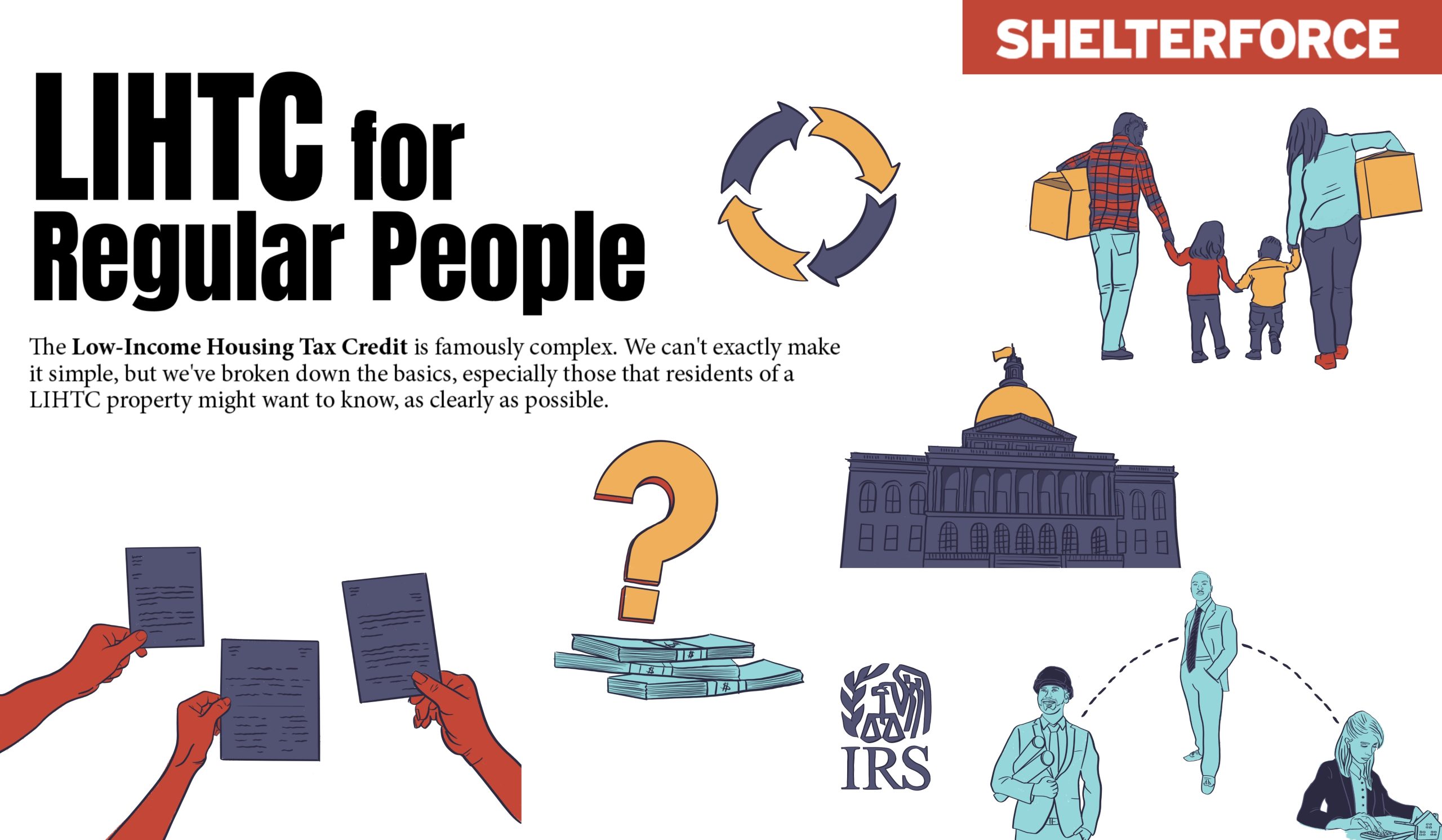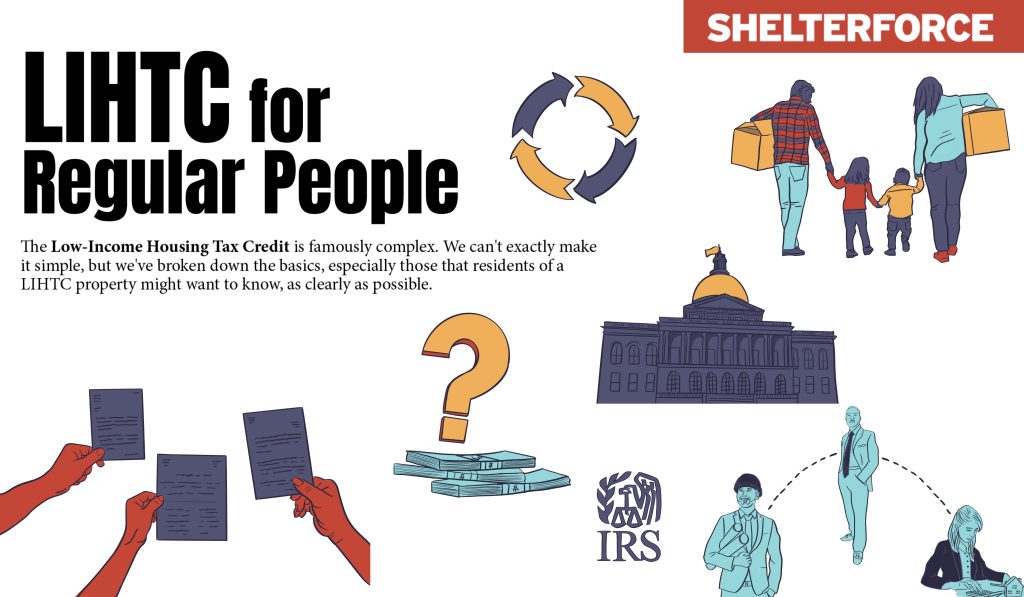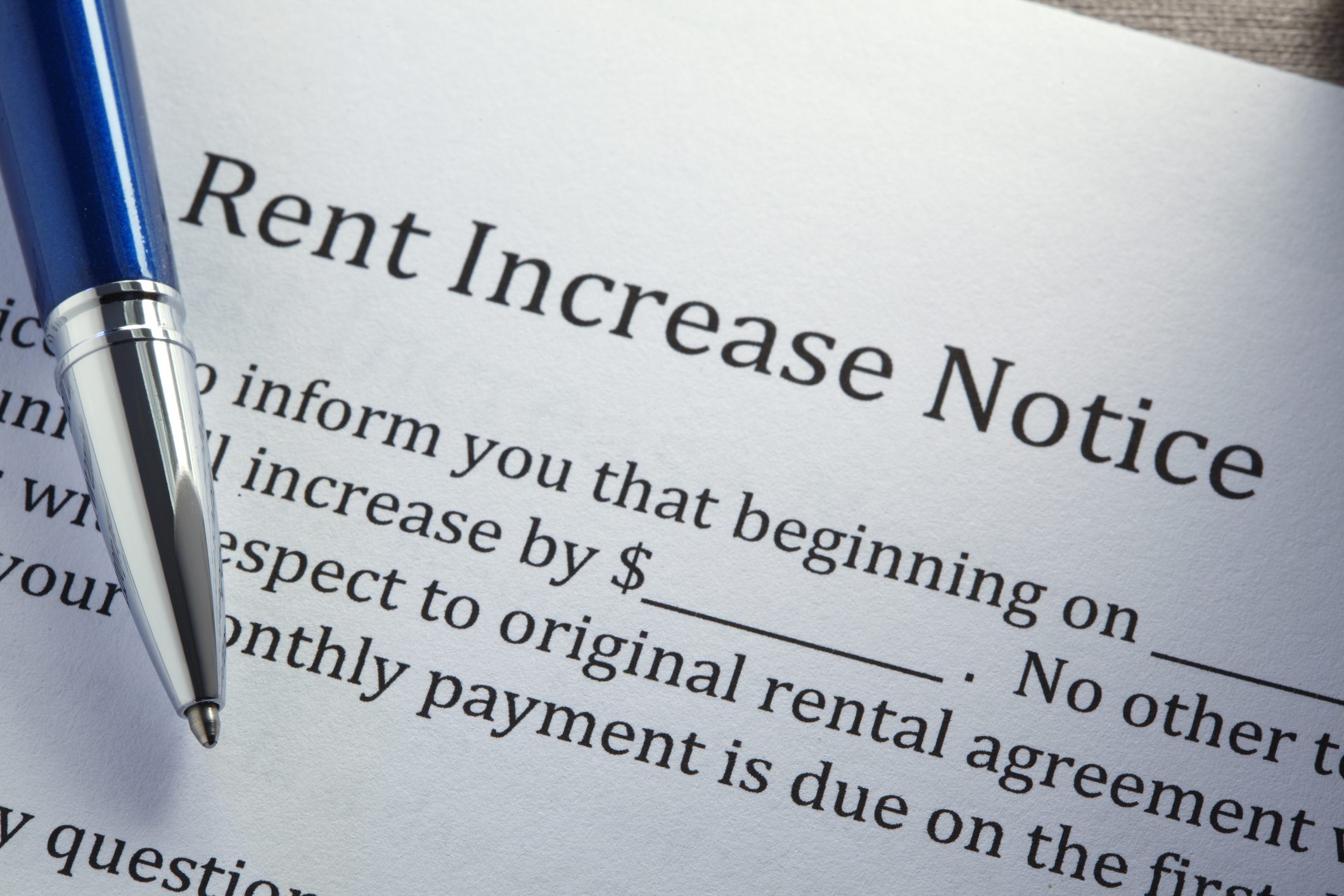This article is part of the Under the Lens series
LIHTC: The Good, the Bad, and the Very Complicated
What are “9 percent” and “4 percent” credits?
How are the tax credits given out?
How do developers turn tax credits into affordable housing?
So who actually owns my property?
Do tax credit properties get ongoing operating subsidies?
How many apartments in a LIHTC development must go to income-qualified households?
Who is eligible to live in an affordable LIHTC unit?
Why am I paying more rent than I can afford in “affordable” housing?
How long do affordability restrictions on a LIHTC property last?
Who oversees owners of LIHTC properties?
How can I find out if my landlord has been cited or fined for LIHTC noncompliance?
What might change at my property in Year 15? Year 30?
What is LIHTC?
LIHTC, often pronounced “lie-tech,” stands for Low Income Housing Tax Credit. The Low Income Housing Tax Credit is a program of the U.S. Treasury. It reduces federal income taxes for 10 years in exchange for making an investment in an affordable housing development, which is required to stay affordable for at least 30 years.
What are “9 percent” and “4 percent” credits?
Two kinds of credits are given under the LIHTC program. The more desirable ones, 9 percent credits, are awarded competitively by state housing finance agencies. They are designed to subsidize about 70 percent of the cost of a project. Investors claim these credits over the first 10 years of the project, which they use to reduce their federal tax liability each year by an amount that’s close to the construction cost of the affordable units in the property times 9 percent.
The 4 percent credits work the same way but have typically only covered about 30 percent of project construction costs. (This is closer to 40 percent now, after a change Congress passed in the second federal COVID-19 relief package.)
The same LIHTC rules and protections apply to a LIHTC project whether it was constructed using 9 percent or 4 percent credits.
How are the tax credits given out?
There is a limited number of tax credits available. The higher value 9 percent credits are allocated to each state (plus Puerto Rico and a couple of cities) based on population. The state’s housing finance agencies in turn award them to developers for specific development proposals through a competitive application process. Each state housing finance agency has its own list of priorities, called a Qualified Allocation Plan (QAP). QAPs include point systems that the agencies use to score applications and decide which proposals get the credits. Typically QAPs will assign point values to various desirable attributes, such as green construction. The QAP is issued annually, usually after a public comment period. Find all the current QAPs here.

How do developers turn tax credits into affordable housing?
Developers who get credits of either kind generally do not owe enough taxes to make use of the credits themselves, so they bring in larger investors. Under existing tax rules, investors cannot simply buy the credits; to claim the credits, investors must have an ownership stake in the LIHTC project. Therefore, developers exchange the credits for equity investments—or a purchase of an ownership interest—in their project. Usually developers go through a syndicator whose job is to match developers with investors who are interested in the credits. There are for-profit and nonprofit syndicators.
So who actually owns my property?
LIHTC projects are typically owned by a company that is itself partly owned by the developer and partly by the investors.
Generally, the investors are what is known as limited partners. They have little control over the day-to-day operations of a project, but have a 99 percent ownership stake, which gives them the right to claim essentially all of the tax credits and other real estate tax benefits.
The developer typically owns only 1 percent of the project, but as the general partner, the developer (or a group it delegates to) is in charge of a project’s day-to-day operations. The general partner can be either a for-profit or a nonprofit.
The partnership agreement will determine the distribution of rental income and other revenue between the partners, but since rents are restricted, profit margins are thin and most revenues go to maintain and operate the project.
Organized residents will most likely be interacting with the general partner. However, the limited partner does have some power—if the general partner doesn’t follow through on guarantees it made about running the project, the limited partner can demand the general partner fix things, or even in extreme cases replace the general partner. Also if there are other kinds of public subsidy that went into the property, the government agencies that issued it can put pressure on the limited partner if something is going wrong.
From a profit standpoint, the tax credits are the most valuable part of a LIHTC project. Once investors claim their credits and the credits are safe from recapture by the IRS, investors generally sell their interest to the general partner or some other investor.
Who are the investors?
Most investors in LIHTC developments are financial institutions, like banks and insurance companies. On top of significantly reducing taxes, investments in affordable housing also count positively toward banks’ Community Reinvestment Act (CRA) ratings, which creates additional incentives for them to participate.
Do tax credit properties get ongoing operating subsidies?
Not through the tax credit program. Though the investors keep getting tax credits for 10 years, the development itself gets no ongoing subsidy. Once it’s developed it must sustain itself on the rents it is allowed to charge.
However, most LIHTC developments have other sources of financing as well, and some of them, such as project-based Section 8, might provide ongoing subsidies.
How many apartments in a LIHTC development must go to income-qualified households?
All developments receiving tax credit assistance must meet one of the following criteria:
– at least 20 percent of a project’s units must be leased to households that earn no more than 50 percent of area median income (AMI)
– at least 40 percent a project’s units must be leased to households that earn no more than 60 percent of AMI
– at least 40 percent of a project’s units must be leased to households that earn between 20 percent and 80 percent of AMI, and the average income of all households must be no more than 60 percent of AMI. (This is known as the income averaging option. For this option, different units will be assigned income limits between 20 and 80 percent of AMI.)
However, in order to claim and use more tax credits, make their applications more appealing, and simplify reporting, most developments agree to lease 100 percent of their units to households that meet LIHTC income limits at the time their lease begins.
Also, to gain a competitive advantage during the credit application process, some owners agree to assign significantly lower income limits to some or all of their LIHTC units, for example, 20 or 30 percent. Which income limit goes with which unit is typically not in the lease, but is in the regulatory agreement. This agreement is required for every LIHTC project and can be found at your county recorder or clerk’s office.

To move into an affordable unit in a LIHTC building you must make no more than the income limit for that unit.
You do not have to leave a LIHTC unit if your income increases enough to exceed the maximum income for the unit. However, if it does, the owner must rent the next available unit to an income eligible household.
You do not have to have a particular immigration status, unless other funding sources that do come with immigration restrictions, such as HUD programs, were also used.
How are LIHTC rents set?
Unlike public housing or Section 8 housing, where a tenant’s portion of rent is typically limited to 30 percent of their income, LIHTC rent is not based on the tenant’s income. Instead, the LIHTC rules only say that an owner cannot charge above what would be affordable to a household that has the maximum income eligible to rent there.
Let’s break these parts down:
- “Affordable”: Affordable is defined as no more than 30 percent of your income.
- “Of a household”: LIHTC rent calculations assume a household size of 1.5 people per bedroom, so a two-bedroom unit has an assumed household size of three people.
- “Maximum income eligible to rent those units”: Whatever income limit that unit has been assigned.
- Also: Where a tenant pays for utilities directly, the owner must subtract a utility allowance from the baseline rent amount.
Note that LIHTC rents are not adjusted based on tenants’ actual incomes or household sizes.
To find the maximum monthly rent for an affordable LIHTC two-bedroom unit whose income limit is 60 percent of AMI you would first look up in HUD’s charts what 60 percent of AMI for a three-person household is in that location. Since those are yearly incomes, you would next divide by 12 to get a monthly amount, and then multiply by the affordability standard of 30 percent.
When can rents be changed?
According to LIHTC program rules, rents can be raised whenever the published average income for the area (AMI) increases. HUD publishes these income limits once a year. Some LIHTC buildings have provisions, called “escalator clauses,” in their leases that allow rents to be changed as soon as the new levels are published, without waiting for the end of the lease. Most wait for a lease renewal.
If the income limits go down, rents do not have to be reduced.
Rents do not change when the tenant’s income changes.
Rent increases must also comply with the lease and with applicable state and local law.

If your landlord is charging the maximum allowable rent (which their financing probably expected them to do), this means the units are technically only affordable to people at the very top of the income range that is eligible to rent them, and most others will be rent burdened or need to rely upon additional supports, such as vouchers.
If a tenant’s annual income is $30,000, for example, and they’re assigned to a unit with an income limit of $60,000, their rent will be set at a level deemed affordable for a person making twice as much as they do. That tenant is almost certainly paying much more than they can afford.
How long do affordability restrictions on a LIHTC property last?
Under federal rules, owners must comply with LIHTC program requirements, including rent restrictions and good cause protections, for at least 30 years. Most states require longer periods. For example, California imposes rent restrictions for 55 years. It becomes more challenging to enforce these requirements after 15 years, however, because the IRS can’t revoke the tax credits after that period.
How do I find out what year my building’s affordability expires and what the affordability levels are supposed to be?
You can look up your building here. Once you know when it was placed in service, you can determine how long it is required to stay affordable.
You can find the income limits upon which rent levels are based here.
Do my landlords have any other obligations to their tenants beyond standard landlord-tenant law? Are they exempt from any part of landlord-tenant law?
Tenants in LIHTC properties are officially covered by good cause eviction protections. However, defining “good cause” is left up to state and local law, and so might be weak, as well as poorly enforced.
LIHTC owners are also prohibited from refusing to lease to a person with a Section 8 voucher because of their status as a voucher recipient. This source of income protection is limited to Section 8 vouchers and does not include other sources of income used to pay rent.
They are not exempt from other provisions of landlord-tenant law, including rent control, unless specifically exempted in local laws.
Read more about tenant protections from the National Housing Law Project.
Who oversees owners of LIHTC properties?
The IRS administers the LIHTC program. During the 15-year compliance period, the IRS can disallow credits or recapture credits already claimed if the owner fails to comply with program rules.
However, it is the state housing agencies that actually carry out monitoring and enforcement. They refer violations regarding eligibility, rent, or conditions to the IRS during the first 15 years.
Since the IRS hasn’t created any enforcement mechanisms of its own beyond credit recapture, after the 15-year compliance period, it’s entirely up to state housing agencies. States can write into their QAPs fines and other penalties that agencies can impose both during and after the compliance period, but few do. These agencies are also often not staffed for significant enforcement efforts. Learn more about how enforcement of LIHTC obligations works, and could work better, here.
How can I find out if my landlord has been cited or fined for LIHTC noncompliance?
There is no easy way, such as a public database to search. However, since state housing agencies report all violations to the IRS, your state housing agency should have documentation of all program violations for a particular project.
You can obtain this information by submitting a public records request to your state housing agency asking for any and all documents related to LIHTC program violations for your property. Though personal taxpayer information may be redacted, violations and related enforcement action can and should be provided. Public records requests can be slow and cumbersome, however. You’ll need to understand your state’s freedom of information law, and make a very specific and narrowly worded request. You might want to seek help from a public interest lawyer.
What might change at my property in Year 15? Year 30?
After 15 years, the ownership of your property will probably change, as the original investors have gotten the full value of their tax credits and are looking to exit the deal. This could look many different ways:
- The investors could sell to the existing general partner or developer, who could keep things as they are.
- Both the investors and the general partner could sell to a third party, who would still be bound by the LIHTC rules.
- The owners could refinance the development with more tax credits, or other funding with affordability requirements, and start the clock over.
- At year 14, the owners could try to exercise the “qualified contracts” process, which is increasingly being used as a loophole to get out of the affordability restrictions before the full affordability period ends.
- The owners could file for bankruptcy and sell off the property, which would remove affordability requirements.
- The owners could become more lax about following affordability requirements now that it’s on the state and not the IRS to enforce them.
- If the development reaches year 30 without adding any new affordability requirements, the owner could start charging market-rate rents.
|
Now through Dec. 31, all donations to Shelterforce will be matched. Double the impact of your donation by supporting our work today. |







What is the typical return on investment / profit that investors expect for investing in LIHTC projects?
The tax credits typically provide the return they are seeking. Plus they get to take depreciation on the properties. Most investors are not expecting more return than getting their investment back, though a problematic few, especially those who purchase the limited investor’s share, are trying to get more (https://shelterforce.org/2020/10/16/refusing-the-right-to-refuse/).